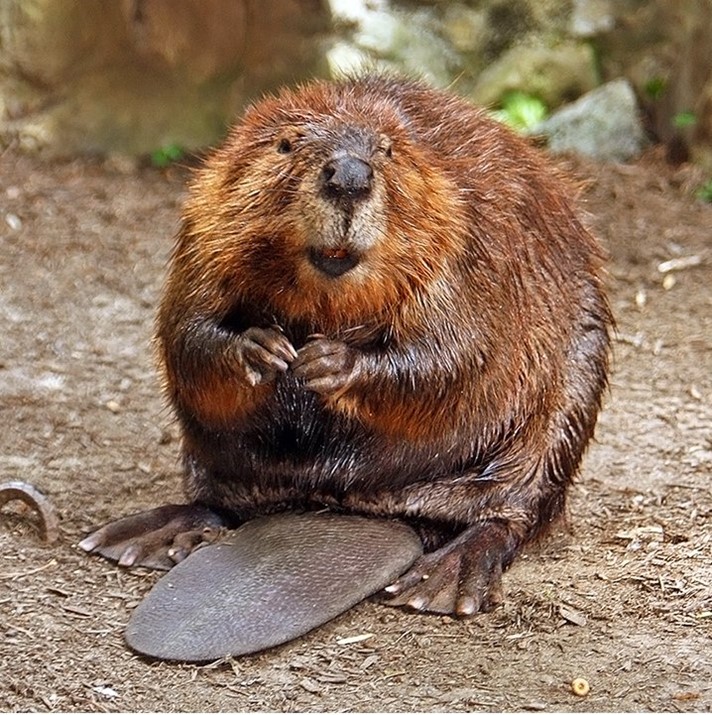
Credit: Steve from washington, dc, usa, via Wikimedia Commons
Beavers are amazing rodents.
They have long teeth that never stop growing; they control their length by gnawing on wood.
They have fat-insulated bodies, webbed feet, and a large flat tail—which make them clumsy and exposed on land but quick and graceful in the water.
Most importantly, beavers cut down trees to dam streams and rivers to make their homes. To many humans, these activities seem destructive.
But the ponds and wetlands they create are essential for hundreds of other species that have coevolved with beavers over the last 10 million years.
These include fish and insects, water birds, amphibians and reptiles, large grazing animals, and a multitude of plant species.
Beaver ponds and wetlands provide food, water and shelter for many of these species—and create huge benefits for the forest:
The ponds protect the woods from fires. Their surface water slowly drains into and recharges the water table. They filter out particulates to purify streams. They slow the progress of, and can even stop, floods. And serve as water repositories in times of drought.
A century ago, trappers had hunted beavers nearly to extinction, for their furs. But around 1900, laws were enacted to protect them, and their population has since rebounded.
Thankfully, beavers now occupy nearly all of their previous range, shaping and improving the landscape from Canada all the way down to northern Mexico.
Background
Synopsis: Beavers are second only to humans when it comes to their ability to reshape the landscape with their dams. As keystone ecosystem engineers, they create wetland habitat for a biodiverse range of other species. Beaver dams raise the local water table, allowing the resulting wetlands to sop up and purify water as it slowly percolates into aquifers. Holding water on the land helps minimize the effects of droughts, fires and floods. But with warmer Arctic temperatures extending their habitat, beavers are building their deep ponds farther to the north, accelerating permafrost thaw. Beaver populations have successfully rebounded over the past century.
- Beavers are well-known keystone species and ecosystem engineers that cause physical changes to their habitat that alter the availability of resources for other species.
- Industrious beavers rank second after humans in their capability to modify their environment and impact other animals.
- Other ecosystem engineers include elephants, prairie dogs, woodpeckers, coral and kelp.
- Beavers are Earth’s second largest rodents after South America’s capybara.
- The oldest known semiaquatic fossil rodents are 30 million years old (Oligocene) and were found in Montana. Their tiny 1/2 inch (10 mm) anklebones reveal they were swimmers.
- An early Miocene (23-million-year-old) fossil beaver family from France was found buried together; they were just 1 ft (30 cm) long but lived together as a community.
- Late Miocene fossil beaver teeth found near Dayville, Oregon, are 7.3 million years old but are virtually identical to modern beaver teeth, indicating a similar lifestyle.
- On Ellesmere Island in the Canadian Arctic, 3.9-million-year-old (Pliocene) beaver fossil bones were found along with sticks bearing marks similar to those made by modern beavers as they gnaw through branches. Beavers may have learned to cache their food in cold water for preservation before they learned to build dams.
- The two extant species of beaver (living today) have head-to-body lengths of about 3 ft (1 m): Castor canadensis is known as the North American beaver while Castor fiber is called the Eurasian beaver.
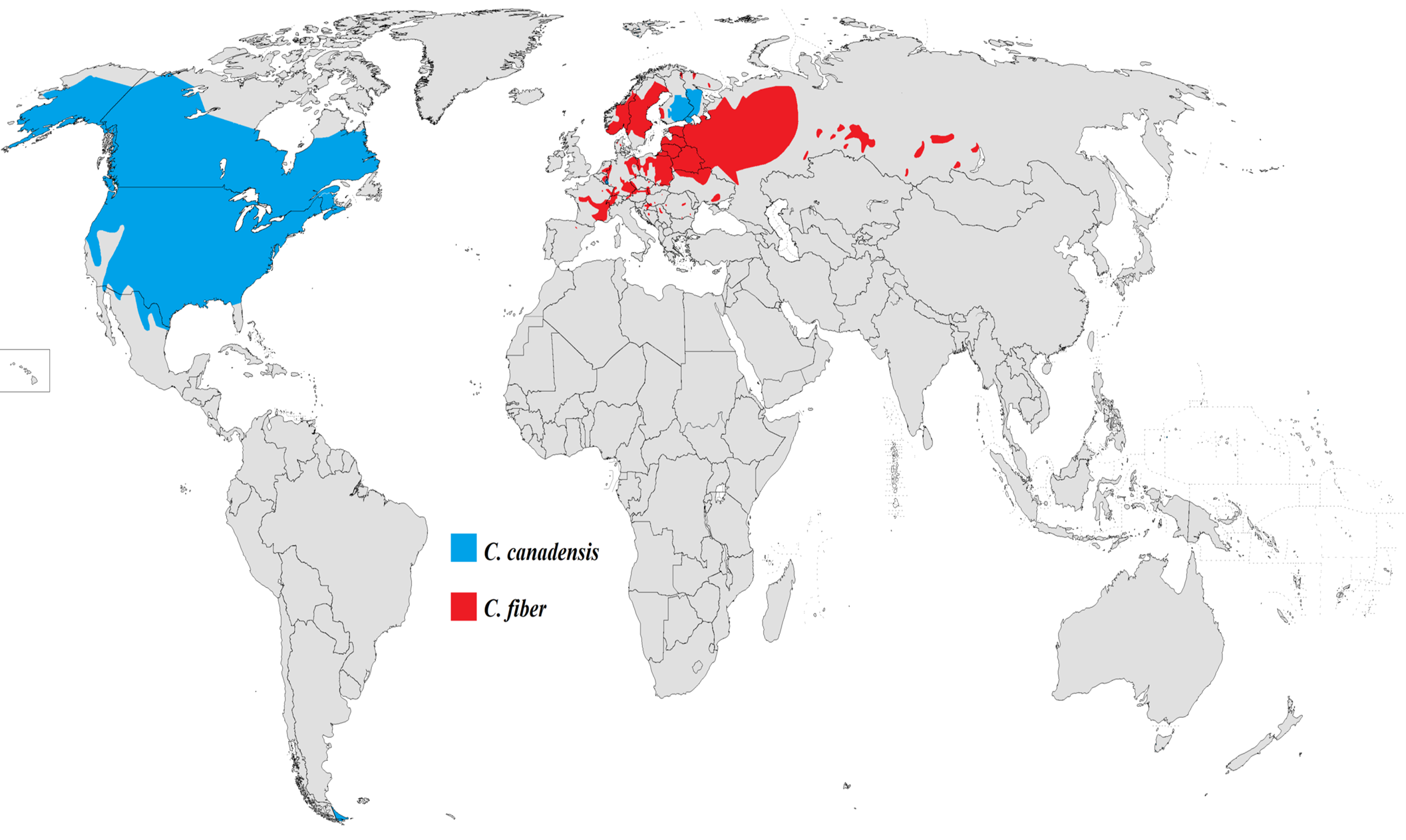
The range of the two living beaver species. The North American beaver (blue) and Eurasian beaver (red) have different chromosome numbers so cannot successfully interbreed. The North American beaver has been introduced in Chile and around the eastern Baltic Sea. Overhunting decreased their ranges, but beaver populations successfully rebounded over the past century.
Credit: Mariomassone, via Wikimedia Commons
- Beavers are unique in many ways:
- They have lustrous, thick, waterproof fur that made them the target of trapping and near extinction in the 1800’s for everything from hats to fur coats.
- Their large webbed back feet propel them at speeds of up to 6 mph (9.7 km/h).
- They have large, flat, scale-covered tails used for swimming and storing fat for winter. They slap their tails on the water surface as an alarm.
- They have nostrils and ears that close and a transparent eye membrane that allows them to see underwater. They can stay under water for six minutes or more if needed.
- They have large incisors that grow continuously and get their orange color from iron-rich protective enamel. Strong chisel shaped teeth enable beavers to cut down trees.
- Beavers eat aquatic plants, leaves, stems, tree bark and softer layers of wood. Their favorites include poplar, aspen, willow, birch and maple, which also happen to be their favorite building materials.
- When they are three years old beavers mate for life. Both parents take care of the one to four kits that are born in the spring with help from older kits that stay with their families for two years. After two years, the youngsters are off on their own to build their own families, dams and lodges.
- In the process of building their homes, beavers modify stream and river systems to create wetland habitat that supports other species ranging from zooplankton to insects, fish, birds, bats, amphibians, turtles, rodents, and larger animals like deer.
- Beavers are nonhibernating amphibious mammals that must live near water.
- They build their domed family lodges with deep moats around them to conceal underwater entrances and to store their winter food cache in water deep enough to ensure the pond doesn’t completely freeze in winter.
- To create their beaver pond moat, these tiny engineers assemble a dam out of heavy rocks, huge logs and long branches.
- Watch them build a dam: Beaver Lodge Construction Squad on BBC Earth.
- They chew through trunks of old trees along the banks, felling them and removing their branches for use in both dams and lodges. Young trees fill in and flourish along the sunny banks where the beavers prune them regularly, encouraging new growth.
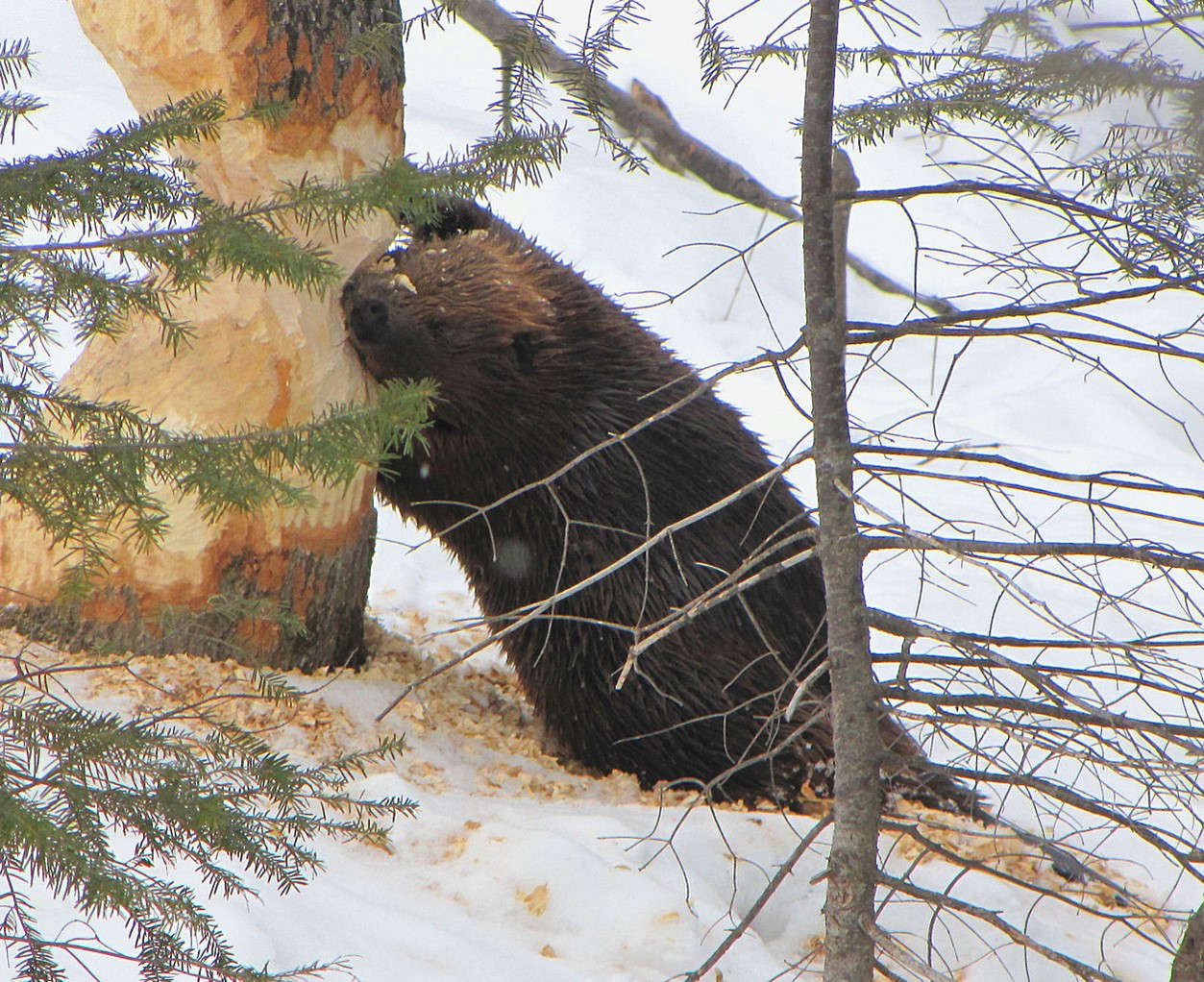
North American Beaver (Castor canadensis), tree cutting, Gatineau Park, Quebec, Canada.
Credit: D. Gordon E. Robertson, via Wikimedia Commons - They drag logs to their dam, which eventually slows and diverts water flow until nearby low-lying areas are inundated.
- Beaver dams are finished with an impermeable lining of clay on the upstream side to prevent water leaks and are armored with logs on the downstream side.
- Beaver patrols monitor their construction projects, rushing to repair a breach if they hear the sound of trickling water.
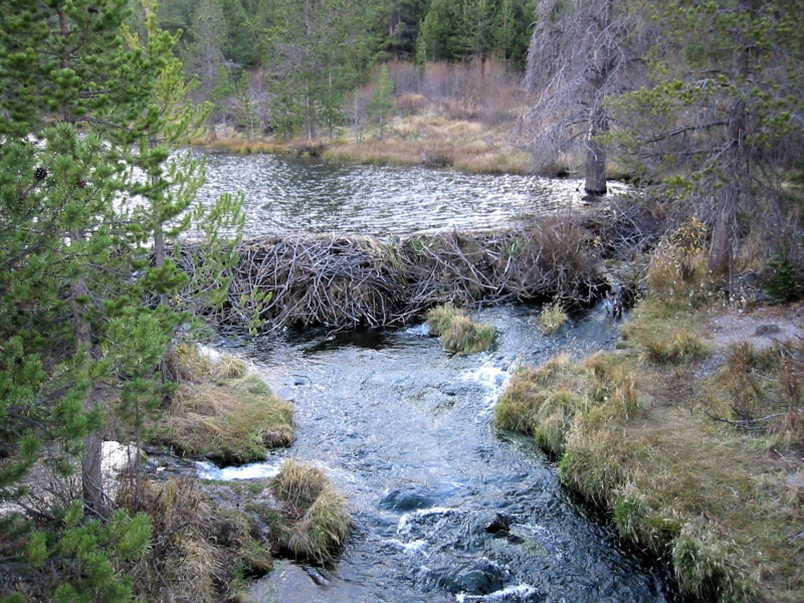
American Beaver (Castor canadensis) dam creates Hat Lake along Hat Creek (in foreground), in Northern California’s Lassen Volcanic National Park.
Credit: No machine-readable author provided. Wsiegmund assumed (based on copyright claims), via Wikimedia Commons - The longest known beaver dam was found in northern Canada using Google Earth in 2007. It is more than half a mile (2,790 ft or 850 m) long and may have been under construction since 1975. The second longest beaver dam in the world is 2,139 ft (650 m) long and is located in Three Forks, Montana.
- Beaver lodges are usually 8 ft (2.4 m) wide and up to 3 ft (1 m) high inside and may be built on the edges or in the centers of ponds.
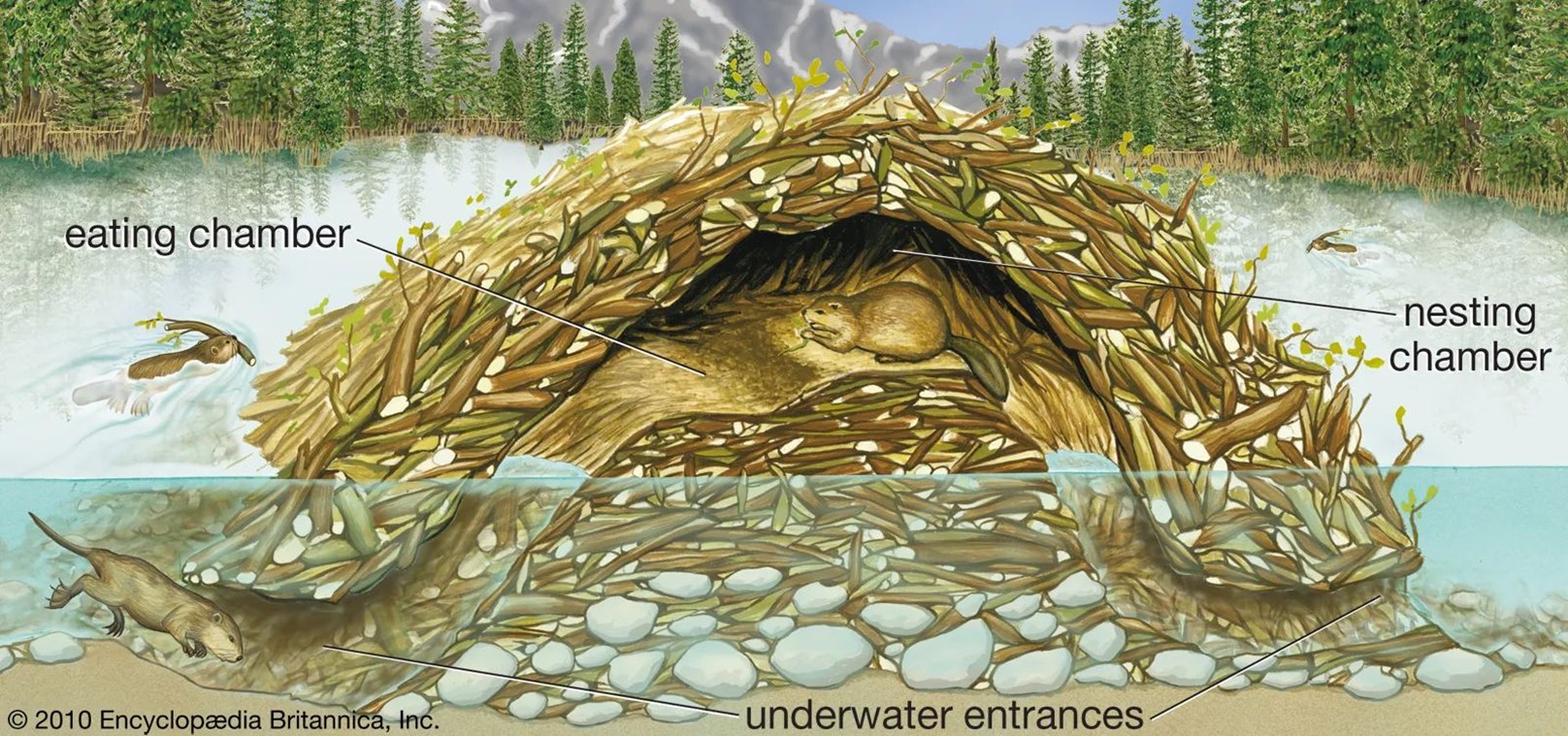
Beavers enter their lodges through underwater tunnels and stay dry above water level in the center of the lodge. Lodges have separate chambers for eating and nesting, and the mound is equipped with a chimney hole at the top to vent stale air. Beaver lodges and dams are made of their favorite foods, which is pretty handy when they need a snack in the middle of winter. Beavers don’t hibernate, but they do slow their metabolism during winter.
Credit: By courtesy of Encyclopædia Britannica, Inc., copyright 2006; used with permission- A beaver refrigerator completes the ideal beaver residence—heaps of young leafy branches are stuck in the muddy pond bottom near the lodge to be preserved by the cold water for winter meals.
- Flooded areas upstream of beaver dams become wetlands, where many of Earth’s species, from microbes to frogs to waterfowl, breed or live.
- Waterlogged wetland soils act as carbon sinks while trapping suspended sediment and excess nutrients that are broken down by microbes.
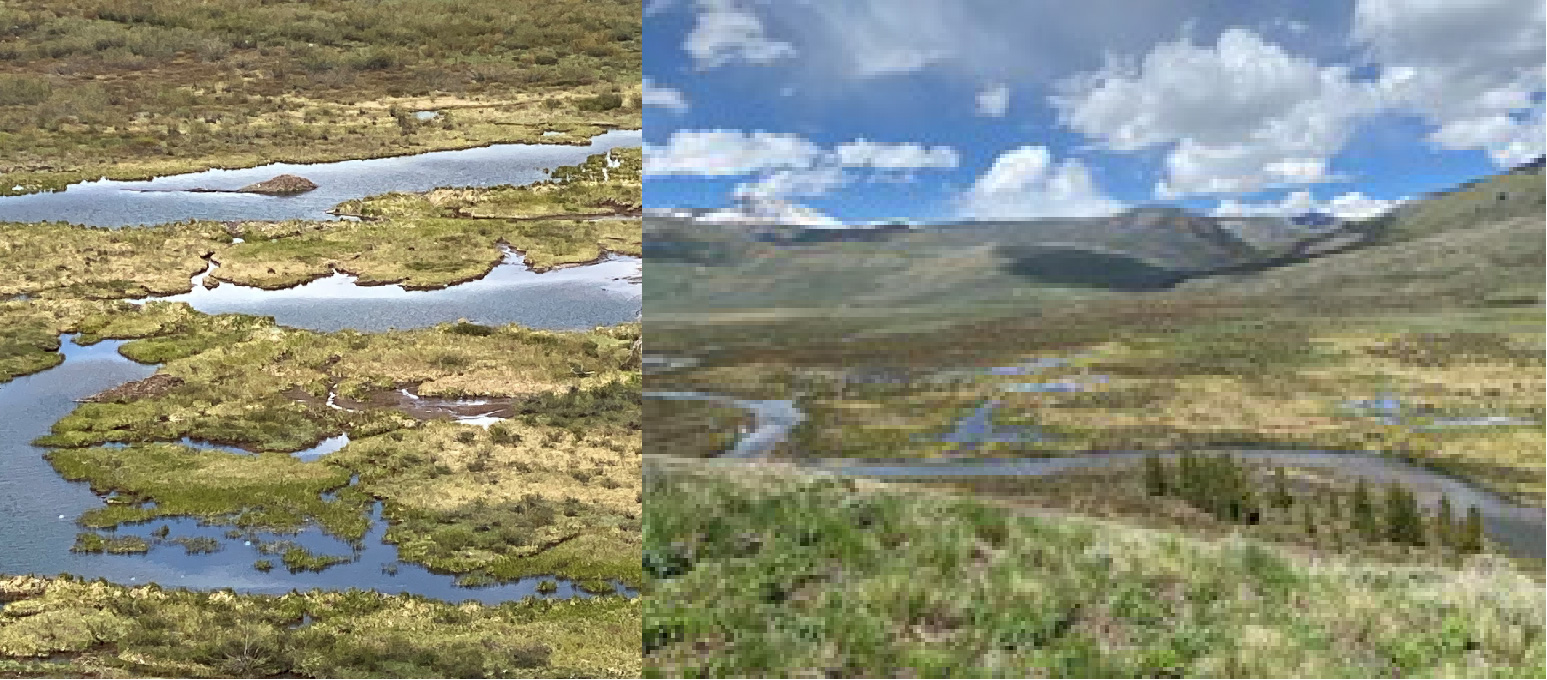
A beaver lodge in wetlands along Colorado’s East River near Crested Butte. These are some of the headwaters of the mighty Colorado River that provide water to much of the American West.
Credit:Juli Hennings, Bureau of Economic Geology - Wetland reservoirs purify and slowly release surface water downstream as well as recharging aquifers.
- Wetlands mitigate natural hazards by storing floodwater and providing damp oases for wildlife in times of both drought and fire.
- Beavers have a huge positive impact on ecosystems and the species that depend upon them.
- Waterlogged wetland soils act as carbon sinks while trapping suspended sediment and excess nutrients that are broken down by microbes.
- As the Arctic warms, forests are extending northward, and young, eager beavers are migrating into new territory, building new wetlands.
- In the 1950’s, aerial photography showed no beaver ponds in the Alaskan Arctic, but today satellite images reveal more than 11,000 ponds.
- As they populate the tundra, their dams prevent some fish from migrating to Indigenous fishing grounds.
- Their deep ponds don’t freeze, warming the permafrost and accelerating thawing and release of ancient carbon stores.
- Studies have shown that in periods of high atmospheric CO2, boreal forests extended into the high Arctic. Since beavers may have followed the limit of forests in the past, they may have already lived in the Arctic, too.

